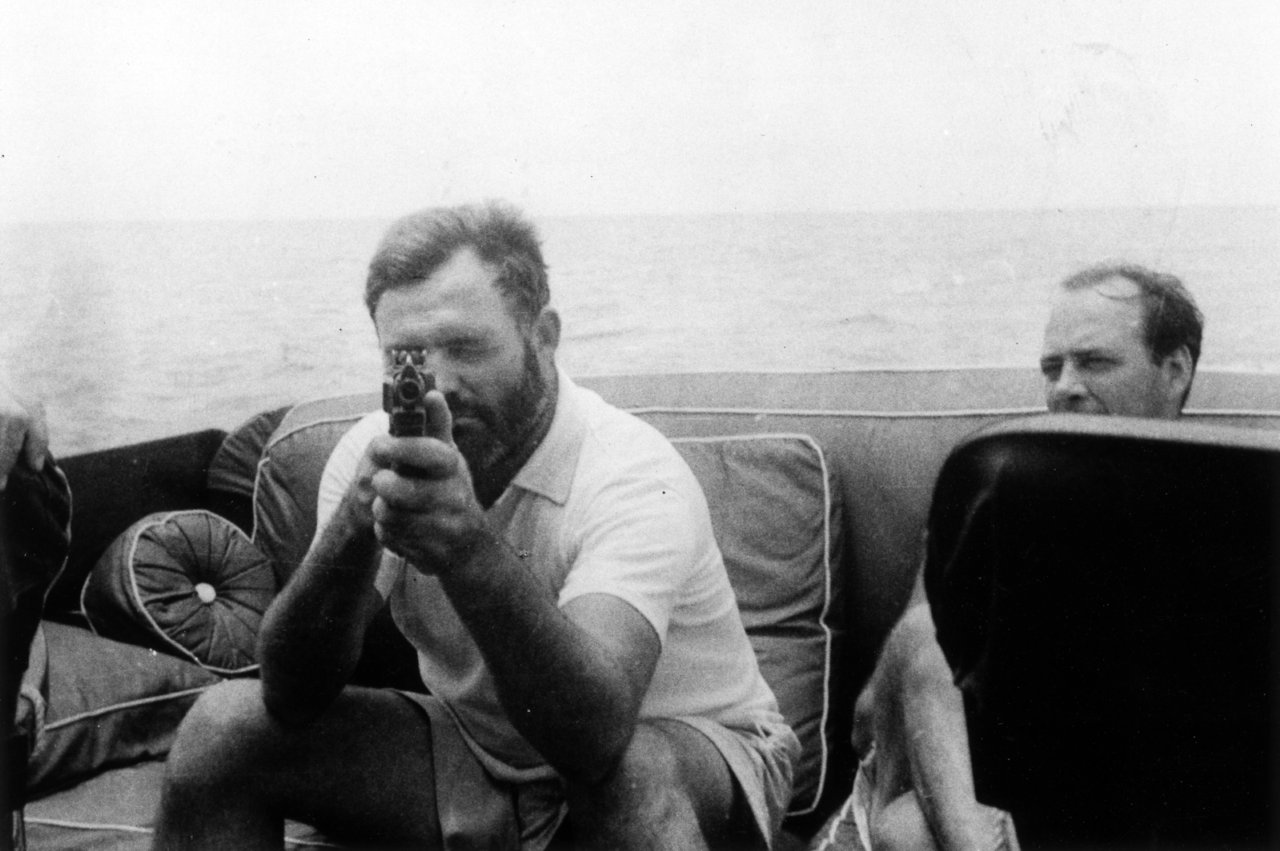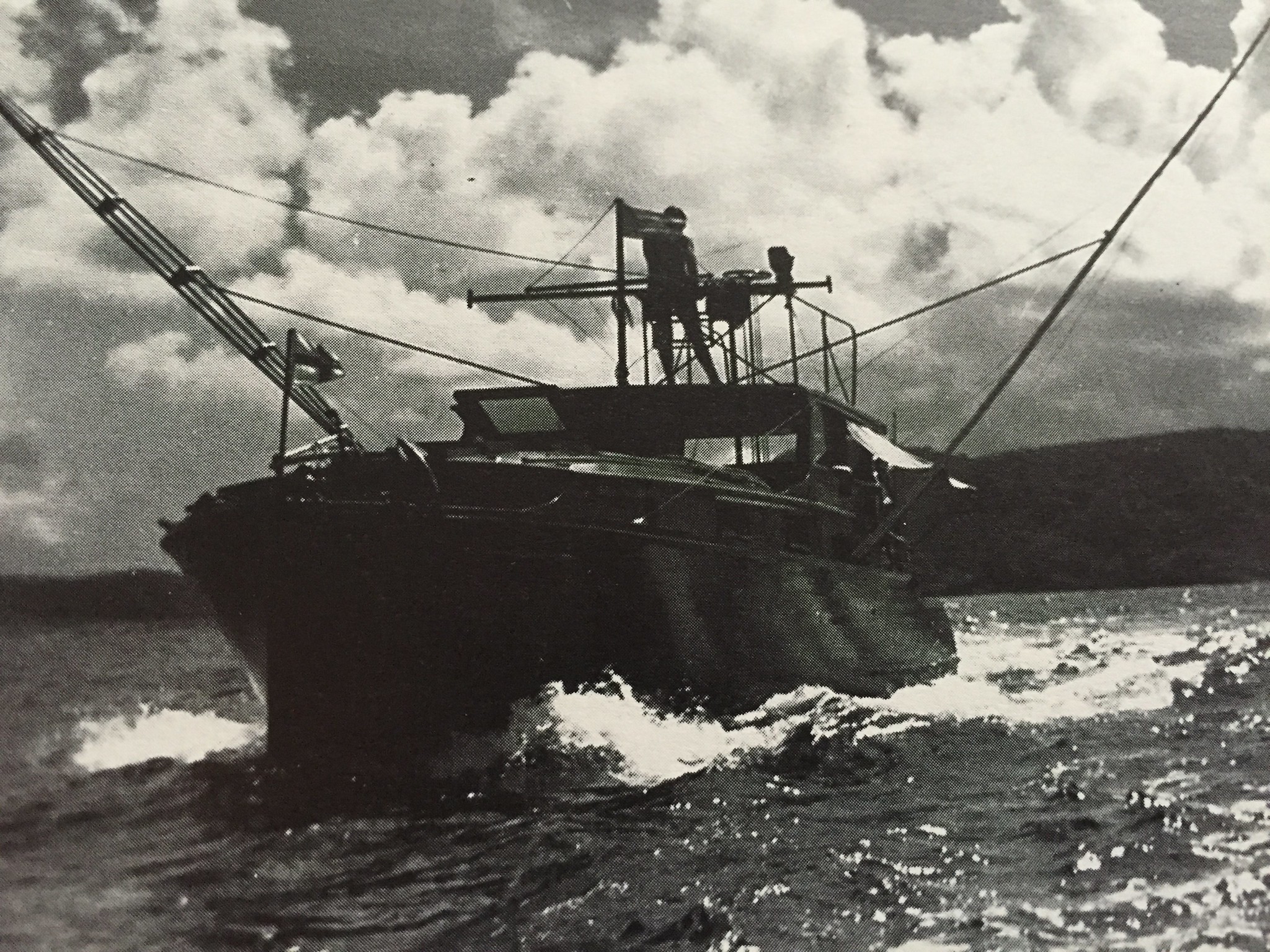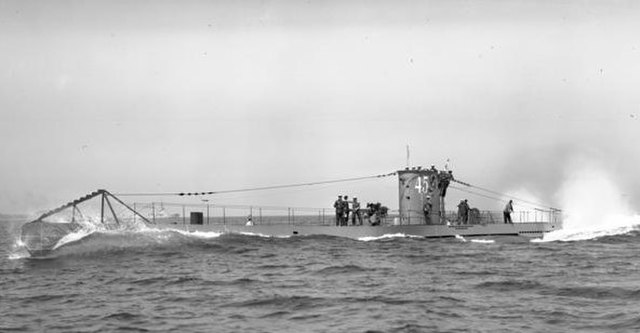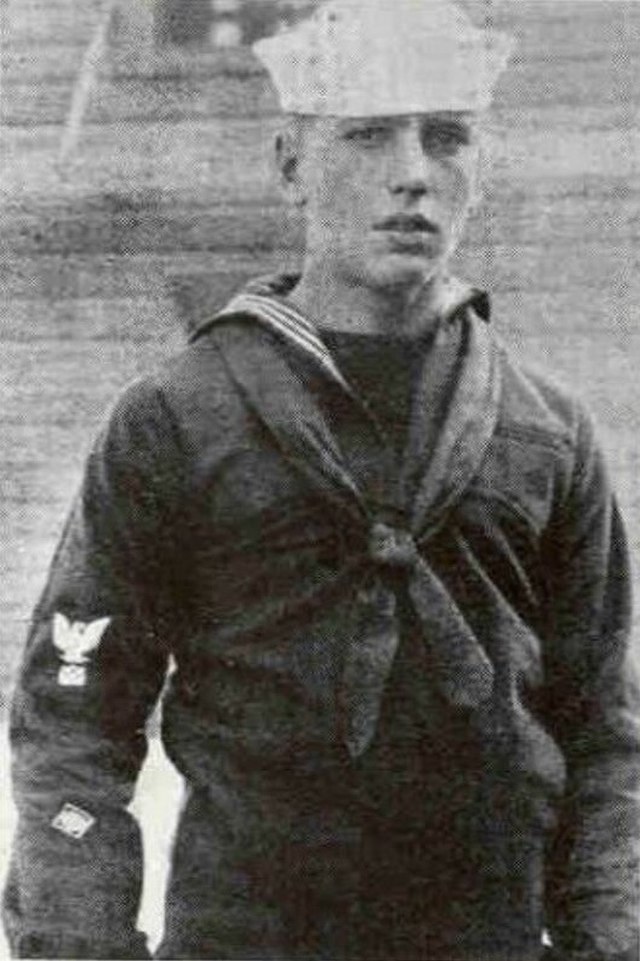With U-boats sinking dozens of ships each month, Hemingway, Bogart, and other citizens tried to help patrol American waters.
-
September/October 2021
Volume66Issue6
Editor's note: Timothy M. Gay is the Pulitzer-nominated author of two books on WWII. His first article on the U.S. civilian response to the Nazi U-boat threat appeared in American Heritage in 2019.

At noon on Wednesday, December 9, 1942, Ernest Hemingway, who loved plumbing the high seas even more than writing about it, was pacing the flying bridge of his 38-foot cabin cruiser Pilar. A pair of powerful binoculars was strapped around his neck. Every few seconds he peered through his field glasses, straining to identify an object roughly six miles out to sea. It was a long gray vessel that, to his novelist’s eyes, was moving suspiciously fast.
He and his crew, among them sons Patrick, 14, and Gregory, 11, had anchored for lunch along the Colorado Reef off the northwest coast of Cuba. Cantankerous crew members had been grousing that the Pilar was no longer stocked with the whiskey that Hemingway had promised. Instead, they had to settle for swigging gin.
From a distance, it appeared that the Pilar, with lengthy poles protruding out of its sides, was no different than the scores of other fishing boats plying the Florida Straits. But upon closer inspection, it was clear the launch was equipped for something other than trolling for swordfish. She was packed to the gills with weaponry: submachine guns, hand grenades, bazookas, and a gnarly looking explosive device that sported handles at both ends. The rectangular bomb looked, Hemingway thought, a little like a coffin.
The U.S. Navy had also outfitted Pilar with special communications gear, including a “Huff-Duff” long-range radio and a sonar detector. She wasn’t pursuing game fish; she was chasing enemy U-boats, with at least the tepid cooperation of the military, from which Hemingway had wangled $30,000 worth of materiel.
He had bought the boat eight years earlier from a shipbuilder in Brooklyn for $7,495, a tidy sum in Depression-era America. “Pilar” was the nickname of Hemingway’s second wife Pauline, the mother of Patrick and Gregory, who was still living in Key West despite her 1940 divorce from the boys’wayward father.
It was also the moniker Hemingway hung on the fictitious leader of the Spanish Republican guerilla band in For Whom the Bell Tolls. “Pilar” was a deliberately malicious choice on Papa’s part: Pauline, a devout Catholic, supported Generalissimo Francisco Franco and his fascist-backed Nationalists, incensing Hemingway. The 1941 Pulitzer committee had unanimously recommended For Whom the Bell Tolls be awarded its prize for letters. But the honor was never bequeathed; the president of Columbia University, the academic home of the Pulitzers, found the novel’s themes – and its author – “offensive and lascivious.”
Hemingway’s provocative reputation also stirred controversy with U.S. diplomatic and military officials in Havana and Washington, D.C. His prewar flirtation with Soviet communism and his enthusiasm for Spain’s left-wing partisans had caused no small amount of consternation at the Federal Bureau of Investigation (FBI) – scorn that Director J. Edgar Hoover and his lieutenants were only too happy to share with the State and War Departments. But Hemingway possessed two things that made him attractive to Navy officers in Cuba and the Keys: he hated Nazis and he owned a boat big enough to (sort of, anyway) keep tabs on enemy submarines.
The distant ship that the writer kept tracking through his binoculars that December afternoon bore the outlines of a U.S. Coast Guard cutter. But there was something about its shape that didn’t square with the Allied boats that he had encountered in and around Havana Harbor.
At 12:15, Hemingway decided to hoist anchor. The Pilar began pursuing the mystery vessel on a north-northwestern tack at seven knots – not conspicuously rushing, but not dawdling, either. If indeed it turned out to be a U-boat, Hemingway wanted to catch it unawares. For months, he and his men (and, over the objections of his then-wife Martha Gellhorn, his two sons) had been rehearsing for this moment.

Their objective was to hoodwink a surfaced U-boat crew into thinking that they were just locals out on a fishing trip, looking to exchange pleasantries with sailors and perhaps sell them some fish. A couple members of Hemingway’s crew were Cubano jai alai players, expert at hitting small targets with thrown objects – like hand grenades. Their (theoretical) m.o. was to pull the Pilar alongside the U-boat, casually lash the vessels together as they bartered over fish, then strike quickly.
Once the Germans realized their true intent, it would be too late, Hemingway (and his Navy enablers) hoped. By then, Papa and his men would have gotten the jump on the enemy sailors, machine-gunned the men on deck, and tossed grenades and – maybe, if their luck held – the coffin-bomb down the hatch, disabling the sub and forcing a quick surrender from the surviving U-boaters.
The plan was, in a word, delusional. The chance that a hard-bitten U-boat commander would permit an unknown ship in hostile waters to get anywhere close to his submarine without unleashing his lethal four-inch (the infamous German 88-millimeter) guns was nil. A couple of salvos would have destroyed the wooden Pilar and, likely, everyone on it.
Fortunately for his legions of fans, Hemingway’s Pilar never caught up to the U-boat that day. Once Pilar closed to about three miles, eyewitnesses remember, her target turned broadside just enough so that Hemingway and his men saw the silhouette of a conning tower attached to a long deck. To Winston Guest, Papa’s old pal and first mate, the sub was so big it looked like an aircraft carrier.
Everyone’s pulse quickened, a scene that Hemingway later captured in his last novel, Islands in the Stream. Young Patrick claimed that his father, in a moment of vainglory that presaged his super-macho exploits two years hence as the Allies’ swept across France, yelled “Battle Stations!”
After trailing the sub for a few more minutes, she disappeared; either the U-boat submerged or was cruising so fast on the surface that the Pilar couldn’t keep up.

Had Hemingway truly sighted and tracked a U-boat? First mate Guest and son Patrick always believed it, although the Navy never confirmed the sighting.
Hemingway and the Pilar’s oft-besotted crew hunted subs for the better part of a year. In May of 1944, Papa flew to London to assume his responsibilities as a war correspondent for Collier’s magazine, writing for the same publications as Gellhorn, his soon-to-be-estranged wife. A self-anointed guerilla leader, Papa and his fellow mercenaries were at the cutting edge of the Allied advance when Paris was liberated in late August of ’44.
Bogie Does His Bit
Ernest Hemingway wasn’t the only iconic American willing to put his life on the line to thwart enemy submarines. In the days immediately following Pearl Harbor, with the West Coast on edge about the prospect of Japanese hit-and-run raids (not to mention an outright invasion), actor Humphrey Bogart volunteered his own 38-foot launch, Sluggy, to patrol the southern California coastline.
Bogie, later destined to star in the film version of Hemingway’s story To Have and Have Not, was a devotee of Papa’s writing. Bogart loved to quote Hemingway’s paean to maritime adventure: “The sea is the last free place on earth.”
An enthusiastic boatman, Bogie had seen the ravages of the Great War as a Navy seaman ferrying wounded doughboys home from Europe aboard the U.S.S. Leviathan. While relaxing on weekends and in between movie shoots, Bogie enjoyed exploring the waters off Newport Beach, where Sluggy was docked.
The boat’s name was meant to pay sardonic homage to the original “Sluggy,” Bogie’s tempestuous – and, sadly, often inebriated – wife, the actress Mayo Methot. Fueled by copious amounts of booze, the domestic life of the Battlin’ Bogarts, as they were known in the tabloids, was so bare-knuckled that humorist Dorothy Parker once wagged that “their neighbors were lulled to sleep by the sounds of breaking china and crashing glass.” So were the family dogs, one of whom had also been dubbed Sluggy.
Parker’s New Yorker colleague James Thurber, an occasional guest, was among the glitterati that referred to the Bogarts’ Hollywood Hills villa as “Sluggy Hollow.” It was an era when alcohol addiction and domestic abuse was not only tolerated but chuckled at.

The 42-year-old Hollywood headliner was an outspoken supporter of FDR’s New Deal, an ardent anti-fascist, and an active member of the Fight for Freedom Committee, all of which impelled him to join the U.S. Coast Guard Auxiliary of Southern California before the U.S. entered the fight.
Bogie volunteered himself and his vessel, which after Pearl Harbor meant passing an exam on California marine geography, hostile and friendly ship recognition, firearm handling, and ship-to-ship and ship-to-shore radio communications.
In February 1942, Bogart officially became a weekend warrior as a member of Coast Guard Reserve Flotilla #21. He and his cronies, including fellow Warner Bros. actors and studio executives, spent considerable time that winter and spring aboard Sluggy and its well-stocked liquor cabinet. Their binoculars and rifles were at the ready as they prowled bays and channels, spoiling for a fight with a Japanese sub like I-17, the enemy craft that attacked an oil refinery outside Santa Barbara in late February of ’42. Fortunately for Warner Bros., its meal ticket never confronted the enemy.
Bogie raised large amounts of money for the war bond effort. But his fight against the Axis was limited to Hollywood back lots, in such vehicles as Across the Pacific, Casablanca, Sahara, and Passage to Marseilles.
Hooligan Sailors from All Walks of Life
The “Hooligan Navy” is sometimes used not only to describe the eclectic mix of civilian boats (like Pilar and Sluggy) that were pressed into duty early in the war, but the overwhelmed U.S. Coast Guard, which in 1942 was trying to patrol America’s shorelines with inadequate personnel, obsolete ships, and outdated weaponry.
For much of ’42 and ’43, the Navy and Coast Guard were indeed bereft of the small warships needed to protect merchant shipping. But for the purposes of this article, the Hooligan Navy refers to amateur sailors, like Hemingway and Bogart, who were willing to risk everything in the war against Tojo and Hitler.
Like the Civil Air Patrol (CAP), the Hooligan Navy attracted men and women from all walks of life: Yachtsmen who belonged to the most exclusive sailing clubs in New York and Newport served alongside fishermen manning undersized skiffs and white-haired Prohibition-era rumrunners. Just as the CAP became a reserve unit of the U.S. Army Air Force, the Coastal Picket Patrol as it was formally known (its more colloquial tag was the “Corsair Fleet” but, despite a Donald Duck-inspired logo personally designed by Walt Disney, that name never stuck in the public mind like the slang-y “Hooligan Navy”), was a reserve unit of the U.S. Coast Guard.
It was the brainchild of Alfred Boiler Stanford, the commodore of the Cruising Club of America and a former U.S. Navy officer and maritime writer, along with his cohort, Rufus Smith, the editor of Yachting, a periodical that catered to the Newport set. Smith became the Coastal Picket Patrol’s first executive officer.
The patrol came into being in May of 1942, the month when so many American freighters (52, allegedly) were sunk by U-boats in U.S. waters that the War Department suppressed the actual figure for fear it would trigger public panic.
Volunteer boats began surveilling the eastern seaboard, keeping a wary eye out for U-boats, two months after CAP began patrolling its skies in the spring of ‘42. The object was the same: to use civilians and their equipment to sound the alarm should a U-boat or its victims suddenly appear.
Just as many CAP planes were ultimately armed, so, too, were many of the boats of the Hooligan Navy. Certain sailing yachts, dyed military gray with Coast Guard numbers painted on their bows, had machine guns installed, many of which dated back to the Spanish-American War of 1898 and had never been fired in anger. Some of those same yachts also carried antiquated depth charges that had to be manually released before being plunged into the water.
As writer Charles Doane put it, “Their primary job was to simply watch and listen for U-boats (with crude sonar equipment), report any sightings to shore by radio, and maintain contacts with potential targets for as long as possible.”
On March 5, 1942, literally the same day that the Civil Air Patrol flew its first reconnaissance mission out of Rehoboth Beach, Delaware, Stanford met with the command of the Eastern Sea Frontier and offered to loan them 30 sailing yachts, all between 50- and 90-feet in length. Stanford also volunteered skippers, skeleton crews, and enough gasoline to fuel several weeks’ worth of voyages.
The Navy remained cool to Stanford’s offer, even when he upped the ante the following month to 70 seagoing craft and 100 smaller vessels. As April headed into May and U-boats claimed more and more victims in the Atlantic, the Caribbean, and the Gulf, Navy and Coast Guard higher-ups reluctantly changed their minds.
On May 1, Admiral Ernest J. King, the crusty chief of naval operations and commander in chief of the U.S. Fleet (and no fan of dilettante sailors) threw in the towel: he officially requested that the Coast Guard work with the Cruising Club and other grassroots organizations to coordinate a Coastal Picket Patrol.
The Coast Guard’s reserve capability had been established three years earlier, in 1939, as Hitler’s Kriegsmarine began terrorizing European seas. U.S. Coasties had for three years at that point been training civilian boatmen to conduct search-and-rescue and law enforcement operations. By 1941, some 8,000 American boaters were members of the Coast Guard Reserve, along with 2,000 to 3,000 boats, most of which were too small or too frail for deep sea expeditions.
In late May, King ordered Eastern Sea Frontier commanders to accelerate their deployment of smaller craft for antisubmarine activities. King mandated that the vessels be “capable of going to sea in good weather for a period of at least 48 hours at cruising speeds.” Fishing and recreational vessels would be accepted in addition to oceangoing yachts. Within weeks, the fledgling coastal patrol had a ragtag collection of boats at its disposal.
Organized by Geographic Task Groups
Six Coastal Picket Patrol task groups were soon organized under the aegis of the Coast Guard Reserve: Northern (Northern New England); Narragansett (Southern New England); New York; Chesapeake; Delaware; and Southern (the Carolinas down to Florida). The mission of these task groups, staggering given the breadth of that spring’s U-boat depredations, was to assist in submarine reconnaissance, ongoing patrol activities, and search-and-rescue operations. Most boats were equipped with a radio; a substantial number were armed with those ancient machine guns and, primitive though they may have been, four depth charges.
Like CAP, they were there to serve mainly as “scarecrows” and “rescue dogs,” discouraging enemy attacks, reporting suspicious sightings, and alerting military officials. Not unlike CAP, assaults against the enemy were to be launched only in the most extreme of circumstances.
For most Coast Picket Patrol vessels, its owner remained on board with a temporary naval rank of chief boatswain’s mate. At the outset, crews consisted of a lot of college-age boys with sailing experience, plus Boy Scouts who had earned maritime badges and those erstwhile bootleggers and rumrunners. In the words of one Coast Guardsman, the coastal patrol volunteers were a bunch of “adventurers and undraftables.”
As Coast Guard historian Dennis L. Noble put it, “Almost everyone who declared he could reef and steer, and many who couldn’t, were accepted.”
The disparate nature of the Coastal Patrol crews gave rise to its “Hooligan” nickname, a label that didn’t sit well with Stanford and some of his patrician charges.
Crews were told to surveil areas along the 50-fathom curve off the Atlantic and Gulf coasts. It was soon determined that they should conduct patrols in squares of about 15 nautical miles. In mild weather, it was easy for crew members to navigate within the 15-square-mile edict. But in dicey weather, it took every bit of their seamanship to keep the boat within its confines. When seas turned rough, Hooligan sailors needed strong instincts and an even stronger stomach.
Tangling with the Enemy
It was rare for a Coastal Picket Patrol crew to encounter a U-boat – but it happened on occasion. The volunteer sailors who shared their memories on the National Sailing Hall of Fame’s documentary on the Hooligan Navy (which originally aired as part of A&E’s “Sea Tales” series) recalled the noxious smell of diesel fuel when they uncovered a surfaced U-boat recharging its batteries. A U-boat commander’s usual reaction was to dive upon spotting a hostile boat, especially if its pursuer was deemed too insignificant for an 88-millimeter retort or a torpedo firing.
In mid-September of ’42, the Edlu II, a yacht operating out of New York, was patrolling south of Montauk Point, Long Island, when it spotted a U-boat trolling the surface. The Edlu II was at that point not equipped with depth charges, yet her skipper chose to close on the U-boat, hoping to surprise her with machine gun fire. Before the yacht could get within firing range, the U-boat dived, vacating the area.
In a separate incident, the Saturday Evening Post, the same periodical that exaggerated a CAP U-boat “kill,” reported in mid-war that the 40-foot reserve craft Jay-Tee had engaged in a spectacular pas de deux with a U-boat. It all started when the Jay-Tee was hunting for survivors of a surface clash between a merchant vessel and an enemy sub.
But when she arrived at the presumed site of the battle the merchant vessel had disappeared – and so had the submarine. A few minutes later, however, the U-boat surfaced within eyesight, only to quickly dive back under water.
The German commander proceeded to surface and dive several more times. Curious, the Jay-Tee’s captain decided to stick around to see what the sub was up to.
A few moments later, the Jay-Tee was abruptly lifted out of the water: the U-boat had bolted to the surface almost directly underneath her!
The Jay-Tee staggered but stayed afloat. Just as quickly, the U-boat submerged again, this time for good.
The Jay-Tee sustained serious damage from her collision with the sub but was able to limp home to port. “The crew’s claim was substantiated by the boat’s broken back, sprung planking and streaks of German paint on the hull,” wrote Noble.
U-boat captains weren’t always as ruthless as their reputation. Off the Florida coast early in the war, one story goes, a Hooligan crew in a cabin cruiser was flabbergasted when a German submarine suddenly surfaced a few yards away.
The hatch popped open; soon the U-boat captain was astride the conning tower. In excellent “Americanese,” the captain hollered, “Get the hell out of here, you guys! Do you want to get hurt? Now scram!”
By early spring ’42, the U.S. Navy at least had developed an outline for its ultimate coastal defense plan. At that moment, it had a fleet of 65 antisubmarine vessels, with hundreds more in the planning stages.
At the end of April, officials handed down new rules: no oil tanker was to haul oil off the Atlantic coast unless it had armed escorts. That rule wasn’t always obeyed, but from that point on, most merchant ships sailed in escorted mini-convoys nicknamed “bucket brigades.” Most bucket brigade sailors and ships were volunteers, proud members of the Hooligan Navy. Still, at night, whenever practicable, merchant ships anchored in harbors.
With German Admiral Dönitz’s September ’42 order to peel back his U-boats into the North Atlantic’s convoy lanes, the threat against America’s coastlines began to wane. Yet until war’s end, there were at least sporadic U-boat sightings along the Atlantic and in the Gulf/Caribbean.
Still, in January of ’43, Admiral King elected to cut the Coastal Picket Patrol by more than a third. Nine months later, it was completely disbanded by the Navy, at roughly the same time the AAF dismantled CAP’s coastal missions. Several of Stanford’s larger yachts, however, were retained for official duty for the duration. Hundreds of survivors from U-boat attacks and boat mishaps were rescued by Hooligan crews in the last couple years of the war.
“[The Hooligan Navy sailors] went out night after night, month after month,” writes modern historian Dirk de Klein. “If they never hurt a U-boat, they were there combing for the debris of what were, in effect, scores of forgotten Pearl Harbors for survivors of torpedoed ships.”

